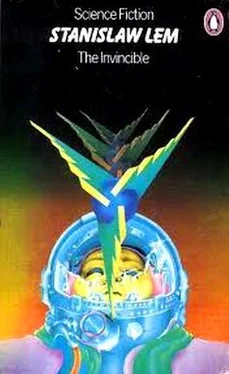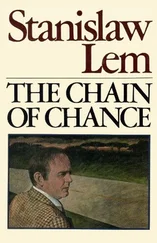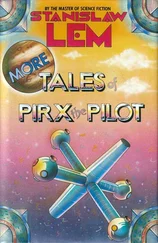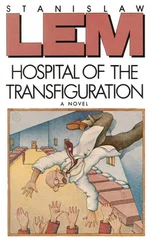Without the novelty which had originally inspired them when they were working in the metallic debris of the “city,” their energy soon dissipated. Hardly a week had gone by when even the Condor work detail failed to bring any more exciting news (like the fact that another corpse had been identified). And the findings that at first had been symbols of sheer horror — the remains of their dead comrades — were now carefully packed inside hermetically sealed containers and stowed down below in the storage rooms of the Invincible. The men whose job it was to continue to search the sand around the Condor, or to rummage through the ship’s interior, experienced boredom rather than a sense of relief. They seemed to have grown oblivious to the fate of the former crew. Their efforts now concentrated on collecting bits of memorabilia, meaningless knick-knacks that had survived their anonymous owners — an old, workworn harmonica or a Chinese puzzle. These objects quickly lost all traces of their origin, and were soon circulated and used as communal property among the Invincible’s crew.
Rohan would never have believed it possible, but in less than a week he was behaving no differently than the rest of the crew. Only on rare occasions, when he was completely alone would he begin to wonder what he was doing there. All this work, their antlike activity, the complicated details of their research: the transilluminations, the search for specimens, the rock drillings (which were made even more difficult by the third step routine), the opening and closing of the energy fields, the laser weapons with their exactly prescribed firing range, the unending visual control, the constant calculations — all this, he realized, was nothing but self-deceit. Basically, they were doing nothing more than wait for some new event, another catastrophe. They were simply pretending that they did not know the real reason for all this busy-work.
At first the men would crowd around the ship’s infirmary every morning to wait for news about Kertelen. He seemed to them not so much the victim of a mysterious attack as some creature who no longer resembled a human being, a monster who had nothing in common with them. It was as if they believed they were in some fantastic fairytale, in which an unknown force from a hostile planet had changed one of them into a monster. In reality, of course, the man was nothing but a cripple. Moreover, it soon became apparent that his brain was simply empty, like that of a newborn baby. His mind was able to absorb all the knowledge the doctors would teach it. Gradually, like an infant, he began to talk. Those who passed the hospital no longer heard the strange whining sounds, unlike any produced by human voices, or that senseless baby’s crying that had been so terrible because it came from the mouth of a grown man. One week later, Kertelen formed his first syllables and began to recognize the physicians, although he could not yet pronounce their names.
By the second week, the men had lost interest in him, especially after the doctors announced that he would never be able to say anything about the circumstances surrounding his accident, not even after he had completed his unusual re-education process and had “returned to his normal self.”
In the meantime the work continued. The crews continued to map the city and to collect details about the construction of the shrub-like pyramids, although no one could figure out their function. Finally, the astrogator decided that further investigations of the Condor would be useless, and therefore were to be discontinued. The spaceship itself would have to be abandoned. Repairing the outer hull was more than they could manage here, especially since the engineers had much more urgent work to do. Only a large number of energo-robots, transporters, jeeps and all kinds of instruments were transferred to the Invincible. The spaceship itself was reduced to a wreck after this salvaging operation. The Condor was made tight. The crew comforted itself with the thought that either they or the next expedition would eventually bring the cruiser back to its home base. At the conclusion of these operations, Horpach directed the Condor troop to continue its work in the north of the desert. They joined Gallagher’s group now under the command of Regnar. Rohan advanced to main coordinator of all research activities. He would leave the immediate vicinity of the Invincible for no more than brief periods, and not even every day.
In an area criss-crossed by many ravines with subterranean springs, the two groups made some peculiar finds. They encountered clay deposits with layers of a reddish-black substance which seemed to be of neither geological nor planetary origin. The specialists were at a loss. It looked as if millions of years earlier vast quanitites of metal particles had settled on the surface of the old basalt mantle of the planet’s solid shell. These splinters consisted either of metal or some metalloid matter — perhaps a huge iron-nickel meteor had exploded in the planet’s atmosphere and then melted into the ancient rock during fiery cataclysms. These metallic fragments might have oxidized gradually, followed by chemical reactions with their matrix and other elements present. Finally they would have changed into these black-brown layers with occasional spots of crimson.
So far excavation had struck no deeper than a shallow level of rock formation, whose complicated geological structure confused even the most experienced of the planetologists. Once they had driven shafts down to the basalt base — itself indubitably more than a billion years old — they discovered that the deposits immediately above contained carbon of organic origin which showed highly advanced stages of recrystallization. At first the scientists believed this layer to have been the original ocean bed. But then they came upon true coal beds with fossils of a large variety of plant species that could only have existed on the dry land. Little by little they gained a clearer picture of the life forms that had existed at that time on the continent of Regis III. Thus they learned that primitive reptiles had once roamed in the primeval jungle, some three hundred million years earlier. Indeed, they returned in triumph one day with the remains of a reptile’s spinal column and the jawbone, though the crew showed little enthusiasm about these finds. Apparently, evolution had taken place twice in the dry land areas. The first extinction of all life occurred in an epoch about one hundred million years back. At that time all plant and animal life seemed to have died out suddenly; the most probable cause would have been the nearby Nova explosion. However, life had developed again after this catastrophe; new forms, new species had arisen. Unfortunately, no exact system of classification could be established by the scientists; the available data were not sufficiently comprehensive. Yet they were positive that no mammals had ever evolved on this planet. Some ninety million years later, a second star explosion had occurred, but this time at a far greater distance from Regis III. This event could be traced by isotopes. According to the approximate values calculated, the intensity of surface radiation was not strong enough to have caused such enormous losses of life. And yet — even more puzzling — from this point on, plant and animal fossils were less and less frequently seen in the rock formations. Instead, the scientists found pressed “clay,” antimony sulfides, molybdenum and iron oxides, salts of nickel, cobalt and titanium in increasingly larger quantities.
There were strong centers within the six- to eight-million-year-old metalliferous strata which were found relatively close to the surface; but this radioactivity was comparatively shortlived considering the age of the planet. During that period something seemed to have unchained a series of violent, localized nuclear reactions, whose products were deposited in these “metalline clay-layers,” Besides the hypothesis of the “radioactive iron meteor,” other, most fantastic assumptions were advanced, attempting to establish some connection between the strange centers of radioactive “hot spots” and the annihilation of the planetary system of the Lyre and the extinction of its civilization.
Читать дальше











